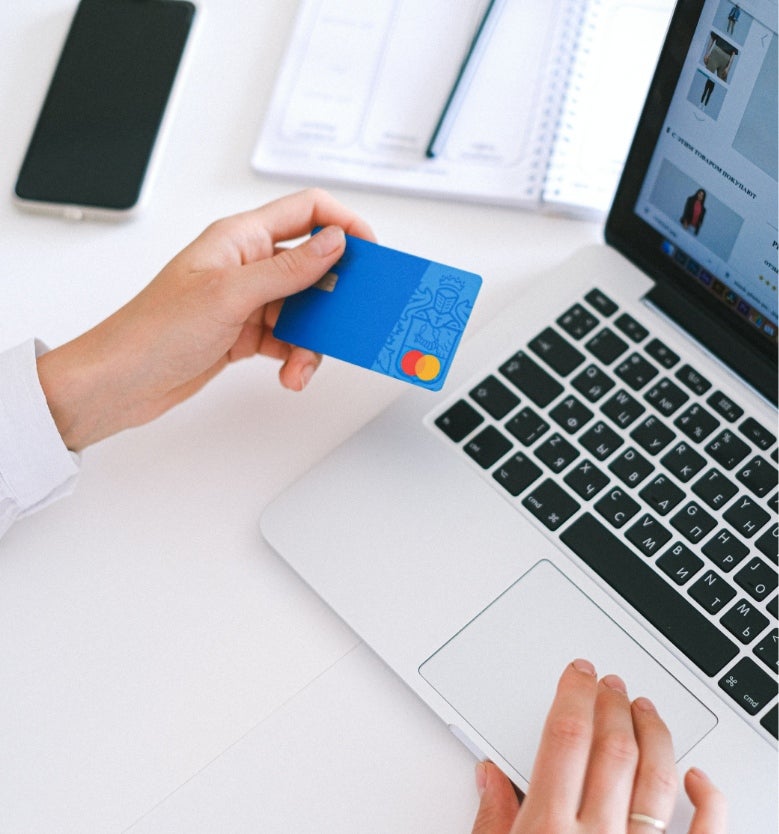
A lot of us have a rollercoaster relationship with money. Whether we’re riding the high of a pay rise, bonus, or jackpot cash-in, or struggling to work out how we’re going to afford our bills for the month, our finances can have a huge impact on our emotional state.
One of the more complex facets of money management is how we choose to spend our hard-earned dollars. While some expenses can’t be ignored, the commercial nature of society might leave some feeling confused about how to balance spending on luxuries and necessities.
In this guide, we’re going to discuss how emotional spending can have an impact on all of us, while also providing practical advice for anyone looking to come to terms with and overcome their spending habits.
Contents

Understanding Emotional Spending (And Retail Therapy)
We’ve all been guilty of splurging with cash every now and then on a gift to cheer ourselves up. Much as with most treats in life, this is perfectly healthy in moderation. However, if this starts to become your go-to coping mechanism during periods of stress, you could find yourself in a challenging position financially.
Let’s better understand the impact of emotional spending, as well as the signs, potential triggers, and the impact of external factors.
Image Credit: Arina Krasnikovavia via Pexels
Signs of Emotional Spending
Whether you’re looking to assess your own behavior or that of others, there are often telltale signs when it comes to emotional spending habits. While noticing one of these doesn’t mean a person has a problem, it’s helpful to know what to look for in order to address a potential issue:
-
You return a lot of what you buy
If most of what you pick up finds its way back to the store after a little while, it means you probably didn’t need it in the first place. Having no use for or realizing you made a mistake when buying an item is a major red flag.
-
You’re competing with others
Emotional purchases aren’t always an internal issue. Sometimes they’re triggered by the need to keep up with, or even outmatch, other people. If a buy was prompted by what you saw someone close to you or in the media getting, it could fall into the emotional spending bracket.
-
You spend money even when it’s stressful
If money is tight, but you still decide to make expensive purchases, it can put a real strain on your finances. It’s unlikely someone thinking rationally would make this decision.
-
You shop for instant gratification
When we shop for things we like, our brains can release a burst of dopamine and endorphins which places us in a state of happiness. While there’s no harm in experiencing this feeling every so often, becoming reliant on it as a means of relaxing could be a sign of a deeper problem.
-
You’re spending to fix yourself
Underlying mental health issues, insecurities, and a general lack of self-esteem could see you turn to shopping as a means of feeling like you’re improving yourself. In reality, this will only bring superficial satisfaction, rather than addressing the core problem.

When we shop for things we like, our brains can release a burst of dopamine and endorphins.
Image Credit: Boxed Water is Better via Unsplash
Causes and Triggers of Unhealthy Emotional Spending
There are many reasons why someone might turn to a form of retail therapy to help manage their emotions. Everyone will have different triggers, but some of the most common include things like:
Anxiety or fear
If you’re nervous about an upcoming event in your life, or just generally anxious, turning to shopping could be a welcome relief from the issue at hand. In this instance, your spending habits serve as a distraction. If you’re just window shopping, this can actually be a handy trick to help you take a mental break. When you start spending large sums of cash, things start to get a lot more real.
Jealousy
It’s only natural to feel a sense of envy when we see other people with luxury items. We’d all love the latest smartphone or games console, but those might not be practical buys for your situation. If you find yourself feeling jealous on a regular basis, try to think about or even write out 4 or 5 things that you’re grateful for that are unique to your life.
Feelings of depression
As we’ve discussed, the rush of endorphins you get when you buy something can help to lift your mood for a short period of time. These purchases might make you happy for a week or 2, but are they going to bring long-term satisfaction? You can get a similar rush of hormones from doing light exercise – which will also have wider health benefits.
Guilt
If you skip a workout, fail a test, or forget an important date, you might feel a sense of guilt. A normal human response is to try and comfort yourself with a treat that takes your mind off things. Whether it’s a new item of clothing, an expensive takeout meal, or something as extreme as a holiday, this impulse buy can have an impact on your finances.
Emotional Spending and the Impact of the Pandemic
The pandemic took a heavy toll on most people. During this period of mass change and uncertainty, many of us were forced to spend excessive amounts of time at home. And while the occasional walk or grocery run helped to partially break our days up, changes to our regular routine saw more people turn to the internet, and online shopping, for an escape.
It would seem that during this period the average consumer discovered that shopping online was fast, convenient, and addictive.
In March of 2022, reports show that people were spending 18% more than they were 2 years prior.

The average consumer discovered that shopping online was fast, convenient, and addictive.
Image Credit: Anna Shvets via Pexels
Despite inflation in the U.S. growing to 8.5% in March of 2022, reports show that people were spending 18% more than they were 2 years prior – representing a 12% increase on what they were forecast to spend, according to pre-pandemic figures.
Perhaps most interestingly of all, year-on-year growth rose across a number of sectors, with 1 notable exception – out-of-home entertainment (such as cinemas, meals out, and other public events).
While industries like sporting apparel, pet shops, cosmetics, home, and software and electronics would all see a growth of 18% to 28%, out-of-home entertainment fell by a whopping 30% between 2021 and 2022.
A clear discomfort around attending large social events on the part of some consumers is a big part of what’s driving this post-pandemic attitude towards spending. When asked if they were comfortable with attending out-of-home activities, respondents replied:
Scroll to view »

While those who answered that they were uncomfortable in any capacity were in the minority (a total of 34.1%), they still represented more than a third of consumers.
There is some good news for brick-and-mortar stores, however. Just 5% of consumers say they are willing to shop exclusively online. In fact, the numbers are in their favor in that regard, with research from McKinsey showing:
Scroll to view »


Just 5% of consumers say they are willing to shop exclusively online.
Image Credit: Sam Lion via Pexels
The Role That Companies, the Internet, and Social Media Play in Emotional Spending
Marketing in 2022 is very different to how it was at the turn of the century. Commercial focus is constantly shifting towards the internet and social media, rather than the traditional form of advertising seen in newspapers, or even on television. With a world of products just the click of a button away, it’s little surprise that more companies are turning their attention to these digital avenues.
When it comes to businesses trying to sell their products, there are a number of ways a company might look to latch on to and harness the power of emotions to push sales:
-
Message targeting
With companies now able to track which pages a customer has landed on, they can directly target users with messages designed to resonate with the part of the consumer journey they were on. This direct form of marketing makes it easier for businesses to hyper-focus on what they think might convince you to convert a sale.
-
Utilising the fear of missing out (FOMO)
Fear of missing out is another powerful tool that marketing departments have learned to use in recent years. Making a product appear as a social necessity, or like a brilliant opportunity for a consumer, will trigger a deep desire to not get left behind.
-
Exploiting emotional motivators
Emotional motivators are core desires which inspire a person to make important decisions. This extends to shopping. Companies do a lot of research to work out what their target audience sees as motivators in their life, then try to target those desires. Some examples include:
Standing out from the crowd
Feeling a sense of freedom
Wanting to feel like they belong
Protecting the environment
Feeling secure and safe in life

Social media is becoming a powerful tool for businesses and retailers alike.
Image Credit: Georgia de Lotz via Unsplash
Social media is becoming a powerful tool for businesses and retailers alike.
Forbes recently reported that as many as 35% of Americans surveyed revealed social media to be “very influential” in their decision to make a purchase.
Worryingly, the same survey found that 55% of respondents cited social channels as a reason for them either going over budget or spending more money than they had intended.
Perhaps unsurprisingly, the younger the demographic, the more impact social media seems to have on their shopping decisions. Forbes went on to highlight the following responses to how each generation uses their socials as part of their regular shopping habits:
Scroll to view »

Not everyone is keen to use social media for purchasing decisions though. Of those who have never made a purchase via a social platform, 45% said they don’t see this channel as a realistic place to buy something, while 33% said they don’t trust social media apps.
But with millions (if not billions) of potential customers spending hours on their socials every day, the consumer base for businesses across the world is more diverse than ever before. Additionally, while a customer might not buy an item directly through a social media link, it puts the item in their mind, which may cause them to buy it at a later date.

The younger the demographic, the more impact social media seems to have on their shopping decisions.
Image Credit: Liza Summer via Pexels
Emotional Overspending Statistics
As we’ve discovered, there is a range of triggers that can encourage people to spend when they realistically shouldn’t. A recent survey by Self revealed how people spend money emotionally.
As many as 77% of the people they asked admitted to doing some form of retail therapy.
As many as 77% of the people they asked admitted to doing some form of retail therapy, with the main reasons being:
49.2%
Buying a new product to feel happier
43.1%
Browsing stores as a sense of escape
30%
Impulse shopping
24.9%
Spending money when they didn’t have it to spend
15.8%
Hiding buys from friends and family
14.9%
Purchasing a product to compete with another person
The data implies this is something which is getting gradually worse over time, rather than better. 64% of Americans have said they increased their impulse spending across 2022, with $314 spent per month on these in-the-moment buys. This is a steep increase from the 2021 and 2020 figures, which saw $276 and $183 spent respectively.
As many as 73% of all purchases made were said to be spontaneous.
In fact, as many as 73% of all purchases made were said to be spontaneous, with 7 in 10 people admitting to impulsively buying something on their phones while lying in bed at night.
When it came to the purchases which made Americans happiest, there was an interesting shift in relation to age brackets. Adults cited the following as the emotional purchases that made them the happiest:

64% of Americans have said they increased their impulse spending across 2022.
Image Credit: Ivan Samkov via Pexels
Meanwhile, American teens would have a slightly different perspective on the items which brought them the most joy:
Perhaps unsurprisingly, these highs don’t always last. The Self study again highlights how financial factors play a big role in the mental health of the average person. It found financial stresses caused the following issues in respondents:

Financial factors play a big role in the mental health of the average person.
Image Credit: Karolina Grabowska via Pexels

Unhealthy Spending Habits in the Average American Home
We’ve taken a wider look at how emotional spending can impact people on an individual basis. But how does this unhealthy habit affect the average American household? And what other unhealthy habits are common? Let’s go through the keyhole to explore what poor habits look like for a typical family.
Image Credit: Karolina Grabowska via Pexels
Signs of Unhealthy Money Habits
Despite being one of the most fundamental skills needed to function in modern society, most of us weren’t taught how to cultivate good financial habits during our education. As a result, some people often find themselves struggling to make ends meet, even if they are fortunate enough to have a decent net income.
Some of the most common signs that a person is struggling with money management include:
No set budget or plan
While working out where every penny is going isn’t a necessity to be healthy financially, it’s alarming if there’s no clear plan of action for where your money goes every month. Sitting down and working out where funds can be diverted after all bills and expenses have been paid is crucial to the successful management of any household.
Dipping into savings
Savings are supposed to be accounts of money that you don’t touch (except in the case of an extreme emergency). If a person regularly feels the need to take money from their savings, it’s a sign that their general money management and spending habits might be poor.
Debts not being paid off
Debt can be crippling and has the potential to multiply over time. If someone decides to spend money on other expenses, and ignore their debt, it could also be considered mismanagement of their finances. It could also be the case that they continue to pay off one set of debts with another.
No set goals or benchmarks
Having a savings goal gives someone the chance to concentrate their focus on finances. This could be a new home, an extension to your existing one, or even something long-term like a college saving fund for a child. A lack of goals or benchmarks could result in money being frittered away, or aimlessly spent.
Warning Signs of Online Shopping Addiction
In extreme cases, some people could become so reliant on shopping as an emotional outcome that it transitions from a habit to an addiction. If you notice a family member exhibiting any of the following symptoms, think about reaching out to them for a chat:
-
High brand items unopened in your home
If you notice a lot of expensive unopened items in the home, it points towards someone making irrational emotional spending choices. If they didn’t have a need for the items in the first place, their decision to continuously buy more products should be a red flag.
-
Someone shops as a form of entertainment
Some family members might see shopping as a type of hobby. While window shopping can be fun, if they’re committing to actual purchases on a daily basis, it could be time to step in and have a word.
-
Lying about how much has been bought
Have you discovered that someone is spending more money than they’re owning up to? Just as with most addictions, people tend to lie about the reality of the situation in order to mask how extreme it is. If they’ve told you they’ve only spent money on a few items, make sure to explore further how true that is.
-
Shopping is becoming a source of friction
If finances are tight as a result of shopping sprees, address it with your family member. If the issue persists, it could cause arguments. If you still don’t notice a desire to resolve the situation, it might be the case that it’s beyond their control.
-
Purchasing is compromising someone’s well-being
The emotional triggers that cause us to spend can be cyclical. That is to say that feelings of depression or anxiety might push us to overspend, but the result of that is just further negative thoughts. If someone gets trapped in this cycle, they might need your help.

Image Credit: Kindel Media via Pexels
The Relationship Between Credit Card Debt and Mental Health
Debt is stressful for anyone. And while credit cards by their nature serve a useful purpose for consumers, mismanagement can quickly see interest rates rise. The toll this takes on your mental health cannot be overlooked.
Some of the most impactful ways this can cause your mental health to worsen include:
Lacking the motivation to do things – including taking the necessary steps to improve your finances
Causing you to make impulsive decisions if you’re experiencing mania
Causing you to avoid doing social things, which in turn makes your mental health worse
Being in debt can cause your anxiety to spike
It could be harder to fall asleep if you’re worrying about money problems
You might not be able to afford the things which you need to stay physically healthy

Worryingly, one report from May of 2022 found that as many as 75% of Americans surveyed said the convenience of being able to put expenses on their credit card negatively impacted their overall mental health.
Source: Debt.com survey
Image Credit: Liza Summer via Pexels
The report goes on to mention how over a third of people feel guilty when they use their credit cards, while the figures also showed:
30%
avoid looking at credit card bills because it’s too painful.
45%
of those who avoided looking did so because they missed a credit card payment.
21%
of people feel stressed directly after using a credit card.
20%
applied for a new credit card solely because they felt sad or stressed.
Average household debt came to $1,000 in total, with 3% of people surveyed said they had debt of $20,000 and over.
Financial Abuse and Exploitation: Spotting the Signs
While not something that instantly springs to mind when discussing issues in the home, financial abuse has the potential to leave someone powerless, isolated, and even trapped. What makes this form of domestic abuse harder to spot is its subtle nature.
Sometimes it can be difficult for the person experiencing the exploitation to even realize that they’re a victim. You could have been convinced that it’s the norm to let someone else manage your finances and assets, rather than having control of them yourself.
It’s important to understand what the signs of financial abuse are:
Not being allowed to buy what you want
Do you have total control over what your money goes towards? If you’re being restricted in what you can buy by someone else, it could be a sign of financial abuse (unless this is an arrangement you’ve already agreed on).
Having to show someone else your finances
Your finances are your business and nobody else's. You might choose to share them with a partner, family member, or very close friend, but this should never be a necessity or requirement.
Not being given access to your money
This is clearly a major red flag of financial abuse. However much you make, you should always be able to immediately access your own money.
Having to pay for someone else
Unless discussed in detail and agreed on by both parties, it should never be your responsibility to pay for the expenses or debts of another person. This is different from lending support freely, which is totally acceptable.
In essence, if you or someone you know ever finds themselves in a position where they are not in control of their own money, you need to do whatever you can to safely separate yourself from the situation.
Move in with a close friend or family member if you have to, or even turn to a domestic abuse shelter if you have no other options.

Practical Ways To Reduce and Overcome Emotional Spending
We’ve looked in detail at the signs, causes, and symptoms of emotional spending. Let’s now focus on the positive aspect – overcoming your vice. If you’ve recognized that you have a problem, there are steps you can take to reduce its impact on your life, and eventually overcome it.
Image Credit: Mikhail Nilov via Pexels
How To Cultivate Healthy Financial Habits
One of the most effective ways to prevent emotional spending from becoming a long-term issue is to learn how to start exhibiting healthy habits on a regular basis. Here’s a positive approach to spending:
Create a monthly budget
Sit down and work out where your money is going every month. You can do this by taking your net pay after taxes, then reducing it by rent, your mortgage, car repayments, and any other recurring expenses you might have. The remainder is what you have to spend on every other area of your life. Set aside a specific amount for shopping.
Pause before you buy
If you’re prone to making impulsive shopping decisions, make sure to take a moment to consider if you really need an item. Is a luxury item something that’s going to bring you joy for a short period of time, or will it actually serve a purpose heading forwards? If you can, waiting a day or 2 before you buy the item can give you a chance to realize if you actually need it.
Start a savings pot
Having a goal to shoot for helps to concentrate your efforts, which in turn means you make more shrewd decisions when it comes to where your cash goes. A savings pot could also represent an emergency fund that you dip into if you need to.
Spend less
While it might sound obvious, or even over simplistic, try to spend less on a day-to-day basis. Shop around for a cheaper deal, avoid impulse buys that you haven’t planned out, and make sure to be wary of special offers and discounts. You might be saving money on the recommended retail price, but you’re still seeing money leave your account.
How To Stop Emotionally Spending
It’s never as easy as flicking a switch and suddenly fixing your problems. Hard work and dedication need to be put in to get to a place where you can feel confident saying you’re in charge of your spending habits.
-
Work out what it’s costing you
Try to equate how much you’re spending on retail purchases to something tangible – like the cost of a holiday, a percentage of your rent, or even how many hours of work it took you to earn that money. It might open your eyes to realize that in just a few months you spent the equivalent of a week in the Bahamas on items that won’t have much long-term use.
-
Acknowledge and avoid your emotional triggers
If you’re fortunate to be able to work out the things which cause you to spend more, do everything you can to overcome them. For example, if it’s boredom, take up a new hobby or go for a walk. If it’s a feeling of being low, try exercising when you get the urge to shop.
-
Set aside a specific budget to shop with
Having a strict budget that you have dedicated to retail therapy is a good stepping stone toward recovery. This can be disposable income that you know you can realistically afford to part with. That doesn’t mean you should spend for the sake of spending, but it does give you a cap to ensure you aren’t going overboard with your purchases. If you think you’ll struggle not to overspend, you could put this budget into an account separate from your household finances.
-
Write a spending journal
One technique that is surprisingly effective is to sit down and chart everything you’ve spent money on during a certain period of time. This could serve to highlight just how extreme your spending behaviors are – which in turn might encourage you to change your habits.
-
Eat before you buy groceries
One age-old technique which is always effective when it comes to saving on your food bill is to never shop on an empty stomach. This can cause you to buy things impulsively and might result in you going over the agreed-on budget for groceries.

Image Credit: Yan Krukov via Pexels
Mindful Money Tips and Advice
Sometimes having some basic advice is enough to equip a person with the tools to fight their bad habits. Here are some wider pieces of advice to keep in mind when trying to better understand money management.
Delete shopping apps and unsubscribe from newsletters
Having immediate access to the avenues that trigger your spending can be too tempting for some. Try to limit how often you’re going to see these by removing apps from smart devices, and taking yourself off the mailing list of any retailers you regularly shop with.
Leave your credit card at home
Credit cards are an all too convenient way to spend money without facing any immediate consequences. With no money coming out of your account as you shop, it’s possible to rack up a big expense without even realizing it.
Assess your finances every week
While monthly checks are probably enough, it doesn’t hurt to sit down and look at where you are on a week-to-week basis. This micro-management of your finances gives you the chance to make immediate adjustments if you notice anything looks different from how it should.
Distract yourself when you’re thinking about retail therapy
By taking your mind off of shopping and focusing your attention on something productive, you can not only prevent the issue but also experience proactive secondary benefits. Create a list of chores you need to do, read a book, write a short story, do some exercise, or even just watch television instead.

Useful Links and Debt Management Support Resources
Sometimes learning how to manage debt (as well as your overall finances) requires additional help. Be sure to check out this comprehensive set of resources for a starting point in the fight against emotional spending and poor money management.
Image Credit: Rodnae Productions via Pexels





